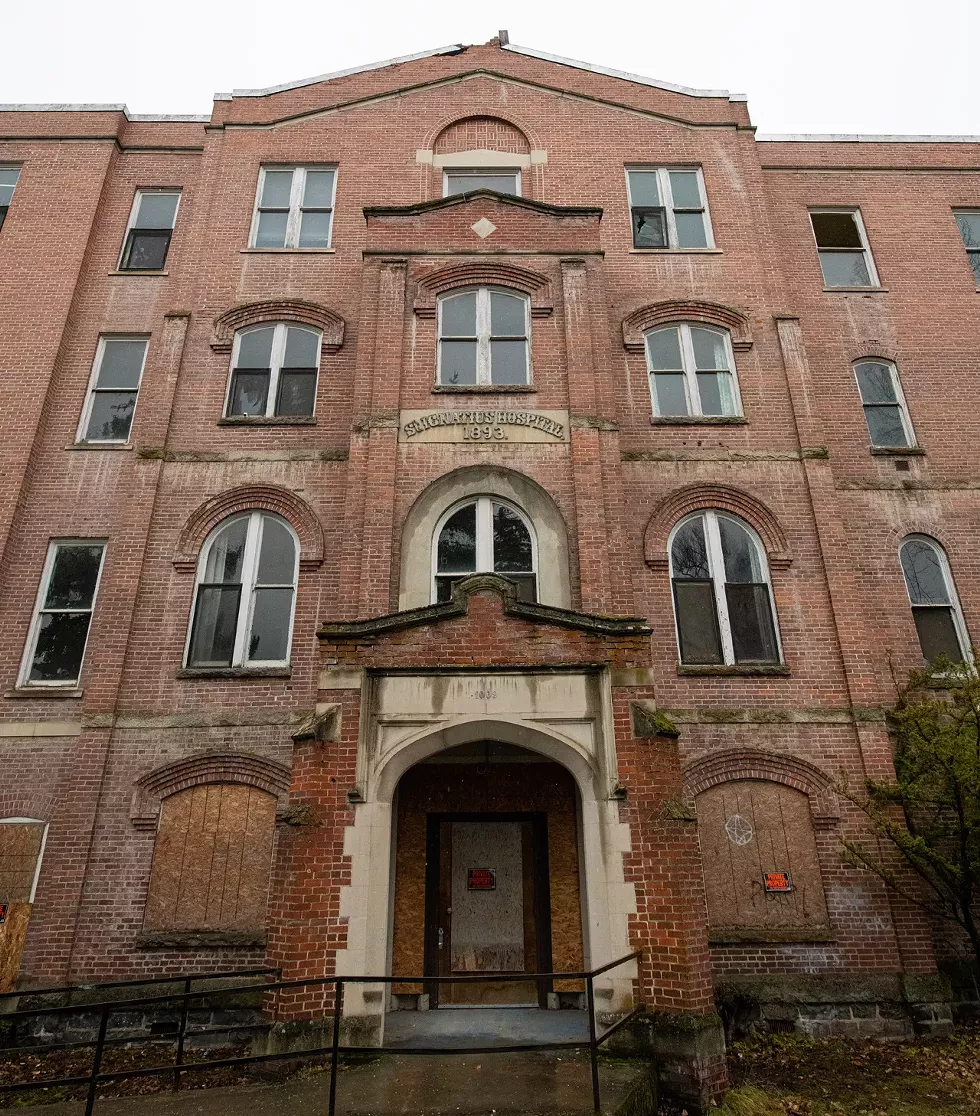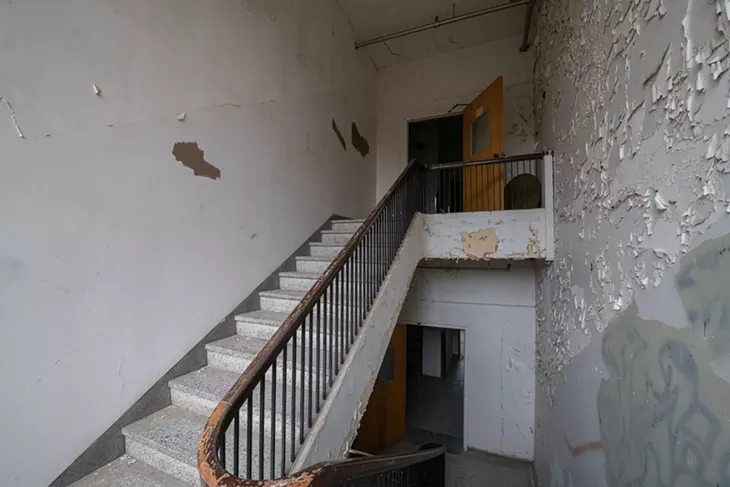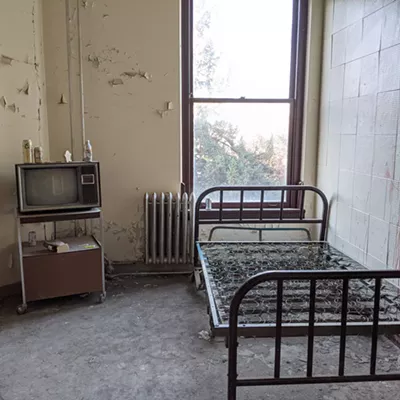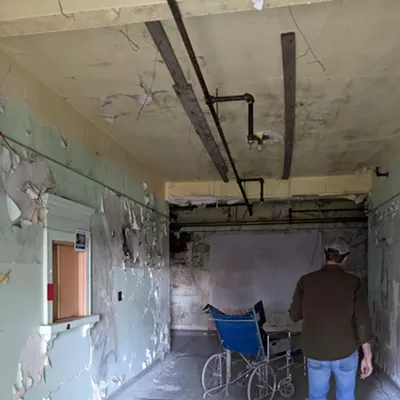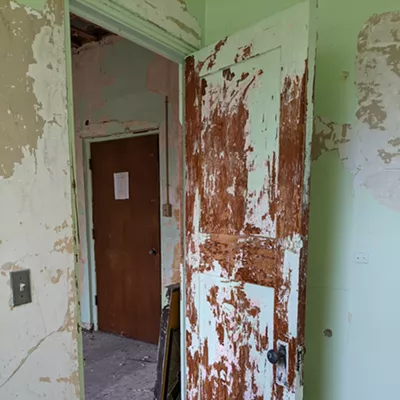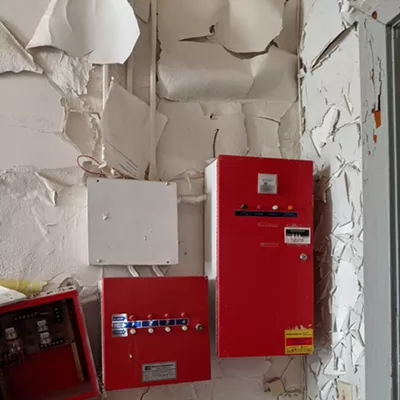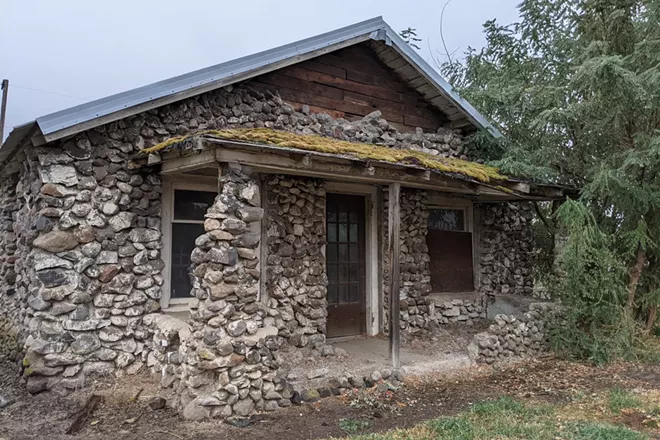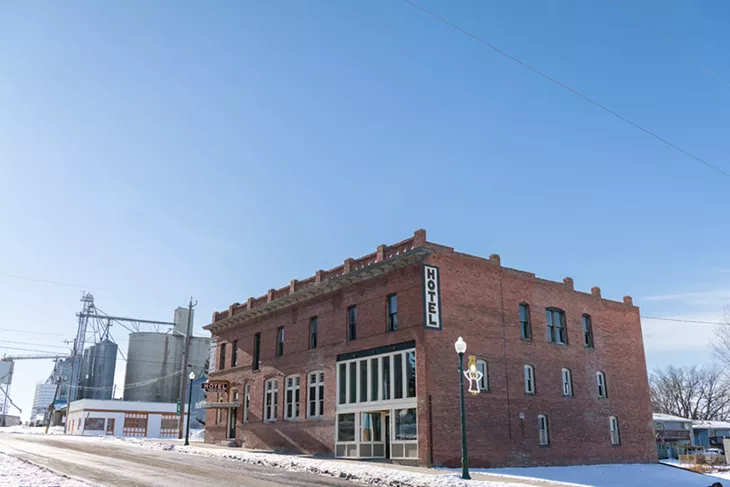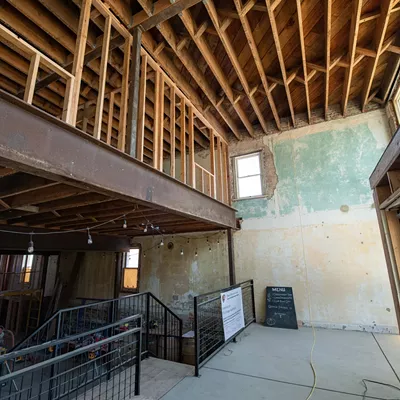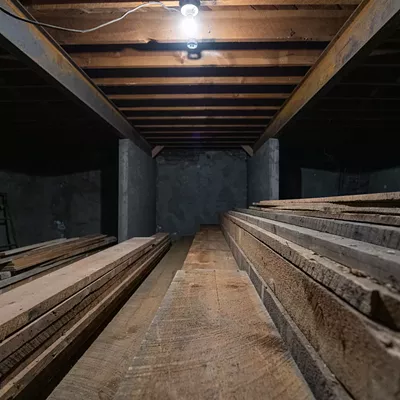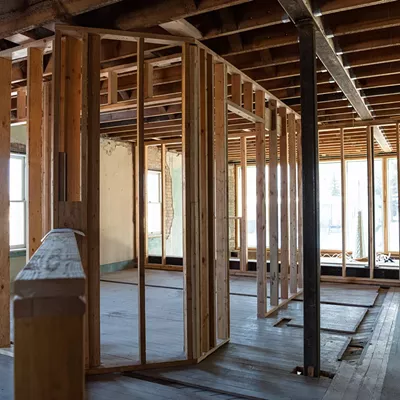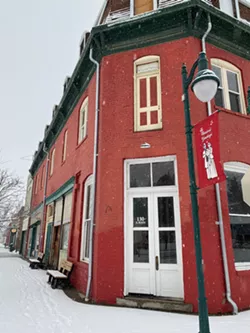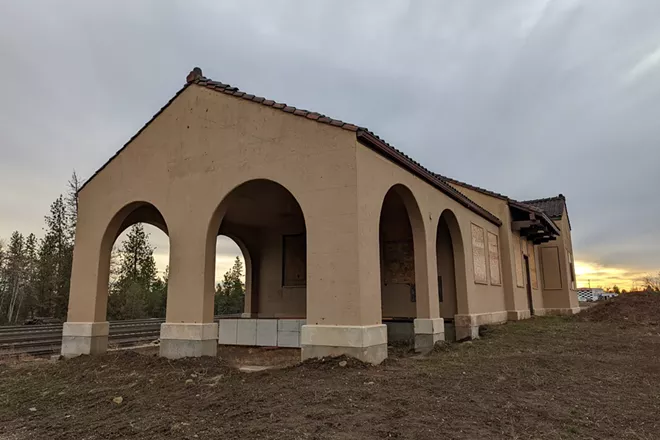It doesn't take long for a really old building to fall apart.
Sitting vacant, the pathway to ruin is only expedited by the whims of nature and time, weather and neglect.
It takes less than 20 years, for example, for plaster and paint to start peeling off walls in crumbly scabs. Wooden floors and walls rot and buckle from water damage even faster. Broken windows give the animal kingdom free rein to move in and make themselves at home, not to mention human vandals with ill intent. None of the above cares how old, nor how significant the architecture, nor how special a building's past may be.
Once a century-old building falls far enough into disrepair, bringing it back to former glory only becomes more challenging — and expensive. If the structure is in a less-desirable or out-of-the-way location, another obstacle arises.
Combined, these factors make preserving old buildings in small, rural towns — towns that 50, 100, 150 years ago thrived, but have a fraction of residents today — even more difficult.
Even so, there are some out there who see beyond peeling paint, crumbling brick, leaky roofs, broken windows and mounting costs. These visionaries are driven by an innate passion to preserve the past so that it can usher in a bright future for a town that, had they not taken on the challenge themselves, may have faded into historical oblivion.
Here, we introduce readers to some of these passionate preservationists working to make sure their small, rural towns don't become ghosts of the glory days.
ST. IGNATIUS HOSPITAL
Colfax, Washington
A haunted reputation is turning out to be a major boon for the derelict, 1893-built brick hospital that looms over the Palouse town of Colfax from a treed hillside.
While new owners Laura and Austin Storm scrounge up funds to begin turning the historic St. Ignatius Hospital into their vision of a modern, mixed-use venue, locals and visitors from afar are paying to spend chilly nights inside its purportedly paranormal-prone halls.
The building's been featured on the paranormal TV show Ghost Adventures, and both the Colfax Chamber of Commerce and Whitman County Historical Society have partnered in recent years to co-host paid ghost tours as seasonal fundraisers. Those tours, currently closed for the winter season, helped elevate the hospital's profile so that the Storms were able to raise about $41,000 last year via a crowdfunding campaign, matched by a $50,000 donation from an anonymous private donor.
"It was a bit of a revelation" when the couple first saw St. Ignatius, Austin Storm recalls. "We were struck by how beautiful it was and were surprised that it was so neglected. How could a building this amazing be here in this area and no one is doing anything with it?"
The Storms aren't new to historic preservation. Previously they restored a building in downtown Moscow, Idaho, where they run a secondhand shop, the Storm Cellar. Four years ago the couple moved to Colfax, bought a 138-year-old house and have since opened Bully for You, a vintage and overstock boutique in yet another historic space they're bringing back to life on Main Street. An unexpected opportunity to purchase St. Ignatius from its former out-of-state owner for $115,000 finally arose in April 2021, seven years after they first laid eyes on it.
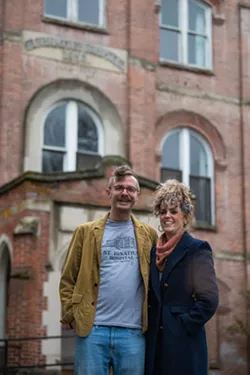
"We knew there was a real possibility that [St. Ignatius] would go away," Storm says. "That it would catch on fire, or just melt into the earth. It's disintegrating because the roof is open, and at some point it would be too late for anyone to save it for any amount of money."
"I couldn't imagine losing something like that," he continues. "It happens all the time, but you can't go back and get buildings like this back. They don't make them like that anymore."
Despite the building's decrepit state, the Storms have big dreams for the five-story, 50,000-square-foot former hospital, which last served as an assisted living facility until shuttering in the early 2000s. Its use as a hospital ceased in the mid-1960s.
Fixing St. Ignatius' leaky roof is priority one now that the Storms have some capital. Multiple failures have caused rainwater and snowmelt to pool in its center, where it's dripped down all the way into the basement for years, causing serious structural damage. (While a structural engineer determined the building is still safe to enter, these unstable areas are roped off on each floor.)
"We are racing against an unknown clock to get that fixed," Storm says. "But we're so optimistic. I can't believe how much interest and support we were able to get in such a short period of time. The response has been amazing."
St. Ignatius truly is a time-capsule relic, having sat unused for the past two-plus decades. While some rooms were converted into apartments in later years, Storm loves showing off the hospital's older areas, like several porches used for tuberculosis patients, each with big south-facing windows to be opened for fresh air. The original hospital operating room was in a turreted tower with floor-to-ceiling windows to provide ample natural light before electricity was installed. On the top floor, he points out a set of stairs to the "spooky" fifth-story lodgings of the mother superior and fellow Sisters of Charity, who ran the hospital from 1893 to 1964.
Old root cellars, now filled with refuse and cobwebs, were built into the hillside facing the back of the hospital to be easily accessible from its kitchen. The latter is an eerie place filled with dark shadows, dust and rust-covered commercial appliances. Boilers for heat were located in a separate brick building on the property with underground steam tunnels between the two. The Storms see that particular structure, with its tall smokestack, as the perfect future home of a craft brewery or similar venture.
As to when something like that envisioned brewery, or hotel rooms, retail spaces, offices and art studios in the main building could become reality, it's too early to say.
"We have a couple years to stabilize it and keep it from getting worse, but we want to get a phase done soon that involves people being able to use it for something other than ghost tours," Storm says. "It's hard to say how long that will take, but three to four years seems reasonable."
ROCK BUNKHOUSES
LaCrosse, Washington
Community pride is driving a small but mighty effort to revitalize the tiny Palouse farm town of LaCrosse, population 310.
It's even in the name of the nonprofit, LaCrosse Community Pride (or LCP), whose members describe themselves as a "feisty team of volunteers" spearheading efforts to transform the town.
The first accomplishment the group checked off was restoring the town's original general store to again house a small market selling groceries and household sundries, along with the LaCrosse branch of the Whitman County Library and a community gathering place. A cafe on Main Avenue where locals gather to talk over coffee, plus the town's original bank, now operating again, are other recent success stories aided by LCP.
"Mostly it's a story of community and people pulling together and turning what was once an empty Main Street into a vibrant one," says member Alex McGregor, whose family has lived and farmed on the Palouse since the 1880s.
The nonprofit received assistance and support from several state agencies and nonprofits, including the Washington Trust for Historic Preservation's Main Street program, which helps communities revitalize their cores, plus the Washington State Historical Society and the state's Department of Archaeology and Historic Preservation.
Next up, and perhaps the most ambitious project so far, is the restoration of five rock-walled bunkhouses and an old service station, all built during the Great Depression.
The tiny houses are being transformed into Airbnb-style guesthouses. The nonprofit envisions the adjacent garage and gas station becoming an interpretive center and museum about the Ice Age floods that geologically shaped the region and were responsible for depositing all the basalt rocks that were later picked from nearby fields and used on the bunkhouses' facade. The structures originally housed transient railroad and farm workers, but until LCP got involved they sat vacant and in a state of constant deterioration for nearly 60 years.
"I can think of the difference it would make for our small town."
"What LaCrosse is noted for is the rock houses, and they were just falling apart," says Peggy Bryan, a retired librarian and LCP member who first pitched saving the structures.
"Wouldn't it be nice to have them saved to benefit the community?" Bryan recalls thinking. "So I looked at the phone number on one door because they were for sale, called, and that is how it started."
LaCrosse Community Pride took ownership of the property in 2014 after learning there was an outstanding tax lien. Three of the smallest rock houses are near completion — the project involved removing all the basalt from the outer walls and essentially rebuilding each from the ground up — yet two across the street from those, plus the gas station, are still untouched.
"Of course when you live in a small community, you know, there are naysayers," Bryan says. "I can think of the difference it would make for our small town, and I think having a vision of what could be, and the future of our town, I think that's the best. That is my goal."
HOTEL LINCOLN
Harrington, Washington
Historic preservation doesn't happen overnight, a fact demonstrated by the 13-years-and-counting project to restore Harrington's 120-year-old Hotel Lincoln.
"The Electric Hotel," as it's also known, being the first place in town to get electricity, opened in 1902 and was once a bustling hub of activity. The two-story brick hotel sits at the southernmost end of Harrington's seven-block main thoroughfare, near an intersection where most traffic these days consists of grain transport trucks rolling through town.
Spokane couple Karen and Jerry Allen bought Hotel Lincoln in 2009 and have a grand vision for its return to prominence as a rural stopover with a dozen or so hotel rooms, plus a main floor restaurant and retail storefront. At the project's current pace, this future is maybe two years at the earliest from completion, thanks to the Allens' steady determination over the years to save the landmark.
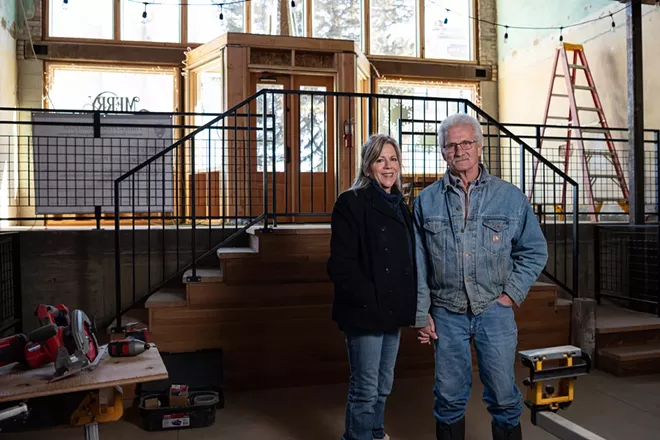
"Our vision has basically stayed the same," Karen Allen says. "We want to restore the whole thing... It's such a neat hotel, and it's unique to the whole area. I don't think you'll find another one exactly like it."
"We came here with the idea of preservation of the building, and getting involved in the community through preservation, and with the idea of adaptive reuse and not letting the heritage die," Jerry Allen adds. "Heritage tourism, agritourism and regular tourism — it's all part of our business plan."
The couple estimate the entire project will cost about $2 million, but they've been helped so far by several grants and donations. They paid $80,000 for the building in 2009, and are reusing as much existing material as possible — from bricks to doors to windows — both to save money and to preserve the hotel's original integrity.
"If I wanted to build this place again from the ground up, it would be an immense amount of money, and I don't know if you could even find the material," Jerry says.
The work's taken more than a decade because of slow funding and because the couple has split their time between their jobs; Jerry is a grain truck driver, and although Karen is now retired from her public school career, she cares for her aging mother. The couple is undertaking most of the restoration themselves, although they have received help from friends and family.
Most of Harrington's 400 or so residents have been supportive of the project, too, some going so far as to volunteer their time and skills.
"Everyone knows everybody, and in this place, people help you and help each other like you can't believe," Jerry says. "In a small town like this, if I don't know what I'm doing, all I have to do is ask my neighbor and he'll tell me."
As a whole, the small wheat country town has seen a fair amount of growth in recent years as fellow property owners have reinvested in other historic buildings, turning them back into public spaces. Two blocks from Hotel Lincoln is the Post and Office, a coffee and gift shop inside the original Harrington post office. There's also the Studebaker Garage, a car museum and event space, and the Harrington Haus, a new pub, is opening soon. Initial efforts to preserve Harrington's historic opera house block began back in 1992. The property has been since listed on the state and national historic registries, and regularly hosts performances and community events.
"There is so much history around here, that's why I love it," Jerry says. "The old construction, it lasts."
ST. ELMO'S HOTEL
Palouse, Washington
Not every historic building can be saved, even when supported by a vocal community. And lately, the potential of preserving one of the oldest structures in the small town of Palouse, Washington, is looking grim.
It's not because the current owners don't want to save the building, but because it might not be realistically or physically possible.
Palouse resident Justin Brown and his wife purchased the 1888-built St. Elmo's Hotel in 2018 with eager plans to renovate and preserve the red brick building in the heart of town. Yet once interior demolition began and a structural engineer took a look, their hopes were dashed. After 134 years, St. Elmo's was showing its age in serious ways.
The two biggest problems involve the hotel's unreinforced masonry walls and overloaded timber joists throughout.
"We didn't purchase the building to tear it down," Brown says. "But obviously for our dollar, and based on the research and studies and consulting we've done with other professionals, it doesn't make sense."
The building requires structural steel supports. From that need, however, another problem crops up: The existing, low-quality brick might not withstand being anchored to said supports. Brown says the hotel's brick walls currently pose a risk of crumbling and caving in, thus the building is currently unoccupied.
"It was [construction] of that era, just multiple layers thick of brick that is meant to take all the loads and stresses of any given structure," he explains. "What we found from day one — and you can't fault the original builders because you don't know the obstacles they were considering — is that it was poorly executed, and the brick is of substandard quality and corners were cut."
The Browns put St. Elmo's up for sale in 2019 (it's currently listed at $199,000), and hope to find a buyer with the means and vision to bring it up to modern building codes.
In response to the building's current predicament, a collective of Palouse residents formed the Friends of St. Elmo's, and successfully petitioned in 2020 for it to be listed on the Washington Trust for Historic Preservation's most endangered places list.
"I understand greatly the desire to preserve these historic landmarks," Brown says. "Local people want to rightfully see the building stay as is, so we accommodated that, but it's been no luck so far."
Brown isn't sure how much longer he'll keep St. Elmo's on the market.
"It's not an endless, open timeframe; things are just deteriorating," he says. "The latest conversation we've had is maybe another year, but it's still tough. You don't want to be the person that tore the building down."
CHENEY DEPOT
Cheney, Washington
Another long effort in regional preservation recently overcame its biggest obstacle, literally and figuratively.
In June 2020, the 1929-built former Northern Pacific railroad depot in Cheney was lifted up onto cherry red steel trusses to make the five-block trip to its new home.
Moving the historic depot off of current BNSF railway property along Cheney's main rail spur was a moment six years in the making. In 2014, the railroad declared the vacant building as "surplus," and it would have been demolished had concerned community members not stepped in, forming the nonprofit Cheney Depot Society with its catchy "SOS" call to "save our station."
Moving the depot was a spectacle, drawing hundreds of residents out on a sunny summer day to watch the technical process slowly and carefully unfold, which has since been documented on the society's Facebook page.
Cheney Depot Society Board President Tom Trulove was Cheney's mayor at the time, and he recalls that his staff was ready to hand over a demolition permit to BNSF. Just in time, a local resident showed up at a City Council meeting to call for the depot's preservation.
Another stroke of good fortune came soon after, when a well-off doctor and former Cheney resident, Peter O. Hansen, caught wind of the depot's potential fate and offered to match $500,000 in donations to save it.
Suddenly, the project had momentum, says board Secretary Susan Beeman. Other donations from big regional organizations, nonprofits and local residents came trickling in, including work in-kind to prep the depot for its big move.
"I think people in town are excited by the move as much as anything else, and it was such an event that it really boosted support and recognition, and resulted in quite a few contributions and volunteers," Trulove says.
Cheney's former passenger train depot — a Spanish mission-style building with tall archways, a tile roof and touches of Art Deco details — ceased operations in the mid-1970s, though Beeman says many residents still recall taking trips to and from its platform.
Now that it's settled onto its new foundation off the Lt. Col. Michael P. Anderson Memorial Highway, between I and Union streets, the depot is ready for the final phase to turn it back into a public space. The Cheney Depot Society needs to raise about $90,000 more to meet grant-matching requirements that will fund the project's completion.
"It's a doable figure, but we would sure like to have a couple big donations," Trulove says. "I think, realistically, we should be able to start site work this spring."
"We've had a huge amount of support from the community," Beeman adds, "including a couple of huge, anonymous donations, one in memory of the men who built the depot for $10,000, and that, to a historic preservation person, just sings."
The society envisions the depot offering public space for events and housing a commercial tenant, like a restaurant or cafe. A patio planned on the south side of the building will offer prime views of the railroad tracks, and a reminder of its past. Displays inside will also showcase the depot's history.
"It's Cheney's connection to the railroad," Beeman says. "This tells a story about our community, and it also tells a story about how we became our community. The rail transportation industry is very forward-looking, and this ties together the past, the present and the future all in this one building." ♦
MORE ABOUT THE PROJECTS FEATURED
Cheney Depot Society: cheneydepot.com
St. Ignatius Hospital: stignatiuscolfax.com
The Friends of St. Elmo's: friendsofstelmos@gmail.com
LaCrosse Community Pride: lacrossecommunitypride.com
Hotel Lincoln, the Electric Hotel: theelectrichotel.com

